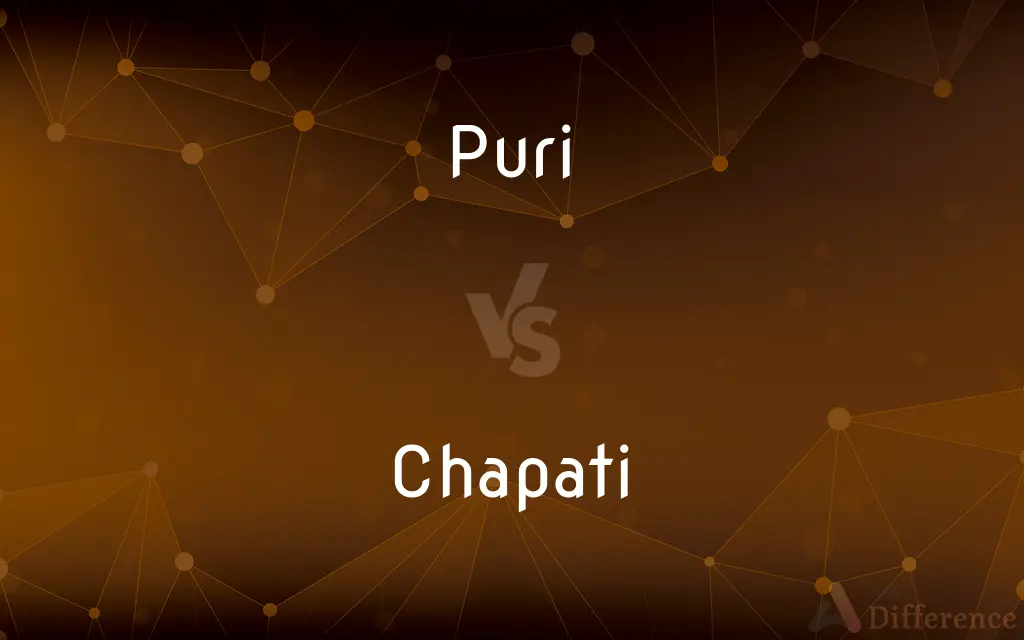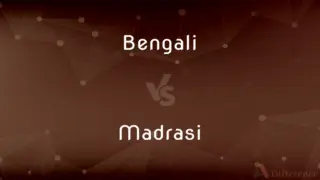Puri vs. Chapati — What's the Difference?
By Fiza Rafique & Maham Liaqat — Updated on April 15, 2024
Puri is a deep-fried bread originating from the Indian subcontinent, known for its puffy and crispy texture, while chapati is a flat, unleavened bread, cooked on a griddle and known for its soft and flexible nature.

Difference Between Puri and Chapati
Table of Contents
ADVERTISEMENT
Key Differences
Puri is typically made from whole wheat flour and is deep-fried in oil, causing it to puff up, whereas chapati is made from the same type of flour but cooked on a dry skillet without oil, leading to a softer texture.
The cooking process for puri involves rolling the dough into small circles and frying it in hot oil until it inflates, while chapati involves rolling the dough into larger, thinner circles and cooking it on a tava until brown spots appear.
Puri is often consumed as part of a festive or celebratory meal due to its rich and indulgent nature, whereas chapati is a staple in daily meals across many parts of India, appreciated for its simplicity and health benefits.
The texture of puri is crispy and it can hold its shape well, making it suitable for scooping up curries and gravies, on the other hand, chapati is soft and can be folded or wrapped around vegetables and meats.
While puri is usually served during special occasions and is considered more of a treat, chapati forms an essential part of everyday cuisine and is valued for its versatility and nutritional content.
ADVERTISEMENT
Comparison Chart
Main Ingredient
Whole wheat flour
Whole wheat flour
Cooking Method
Deep-fried in oil
Cooked on a griddle without oil
Texture
Crispy and puffy
Soft and flexible
Typical Use
Festive or celebratory meals
Daily meals
Health Aspect
Higher in fat due to frying
Lower in fat, more nutritious
Compare with Definitions
Puri
Requires oil for cooking.
Heat the oil to the right temperature before frying puri to ensure it puffs.
Chapati
A staple Indian flatbread cooked on a griddle.
Chapati is typically served with lentil soup or cooked vegetables.
Puri
A type of Indian bread that is deep-fried until puffed up.
Puri is often served with potato curry.
Chapati
Low in fat and considered healthy.
Chapati is a good option for those monitoring their fat intake.
Puri
Known for its golden color and crispy texture.
The puri should be golden and fully puffed when properly cooked.
Chapati
Made from unleavened dough.
The chapati dough does not require yeast or baking powder.
Puri
Eaten during special occasions like festivals and celebrations.
Puri is a popular choice during Diwali feasts.
Chapati
Part of daily meals in many Indian homes.
Chapati is a common accompaniment to most meals.
Puri
Can be sweet or savory depending on the preparation.
Sweet puri is sometimes flavored with sugar or jaggery.
Chapati
Known for its soft and flexible nature.
Chapati can be easily wrapped around pieces of grilled chicken.
Puri
Puri (Odia: [ˈpuɾi] (listen)) is a coastal city and a municipality in the state of Odisha in eastern India. It is the district headquarters of Puri district and is situated on the Bay of Bengal, 60 kilometres (37 mi) south of the state capital of Bhubaneswar.
Chapati
Chapati (alternatively spelled chapatti, chappati, chapathi, or chappathi; pronounced as IAST: capātī, capāṭī, cāpāṭi), also known as roti, rotli, safati, shabaati, phulka and (in the Maldives) roshi, is an unleavened flatbread originating from the Indian subcontinent and staple in India, Nepal, Bangladesh, Pakistan, Sri Lanka, East Africa, Arabian Peninsula and the Caribbean. Chapatis are made of whole-wheat flour known as atta, mixed into dough with water, oil and optional salt in a mixing utensil called a parat, and are cooked on a tava (flat skillet).It is a common staple in the Indian subcontinent as well as amongst expatriates from the Indian subcontinent throughout the world.
Puri
Variant of poori.
Chapati
A flat, unleavened, disk-shaped bread of northern India, made of wheat flour, water, and salt. Also called roti.
Puri
A type of unleavened bread from India and Pakistan, usually deep-fried.
Chapati
A flat, unleavened bread from northern India and Pakistan.
Puri
In Bali and other parts of Indonesia, a palace, or other residence of a member of the royal family or ruling class.
Chapati
A flat pancakelike bread cooked on a griddle, originating in India.
Puri
See Euxanthin.
Chapati
Flat pancake-like bread cooked on a griddle
Common Curiosities
What is puri?
Puri is a deep-fried Indian bread made from whole wheat flour.
Is puri considered healthy?
Puri is higher in calories and fat due to being fried in oil.
Can chapati be used for diets?
Yes, chapati is low in fat and high in fiber, making it suitable for many diets.
What meals are puri typically served with?
Puri is often served with curries and sweet dishes during festive occasions.
How is chapati cooked?
Chapati is cooked on a dry skillet called a tava.
Can puri be eaten daily like chapati?
Due to its higher fat content, puri is not typically eaten daily like chapati.
Are puri and chapati made from the same flour?
Yes, both are primarily made from whole wheat flour.
Which is quicker to prepare, puri or chapati?
Chapati is quicker to prepare as it does not require heating oil for deep frying.
How do the textures of puri and chapati differ?
Puri is crispy and puffy, while chapati is soft and flexible.
Is chapati easy to digest?
Yes, being low in fat and not fried, chapati is considered easy to digest.
Can chapati be made without oil?
Yes, chapati is typically made without oil.
Share Your Discovery

Previous Comparison
Bengali vs. Madrasi
Next Comparison
Ref vs. FridgeAuthor Spotlight
Written by
Fiza RafiqueFiza Rafique is a skilled content writer at AskDifference.com, where she meticulously refines and enhances written pieces. Drawing from her vast editorial expertise, Fiza ensures clarity, accuracy, and precision in every article. Passionate about language, she continually seeks to elevate the quality of content for readers worldwide.
Co-written by
Maham Liaqat













































